The Greater Bilby has experienced another year of prosperity in breeding and reached a record population estimate of at least 3,315 individuals, according to the annual Australian Wildlife Conservancy (AWC) Bilby Census.
The annual Bilby Census was conducted in the last 12 months at six Australian Wildlife Conservancy (AWC) protected areas – Mount Gibson (WA), Yookamurra (SA) and Scotia (NSW) Wildlife Sanctuaries along with the newly introduced population at Newhaven Wildlife Sanctuary (NT) and two partnership project areas in the Pilliga and Mallee Cliffs National Park (NSW).
In 2023, the overall estimated Bilby population at AWC sanctuaries is at least 3,315, more than double the 1,480 estimated individuals in 2022 and 1,230 in 2021.
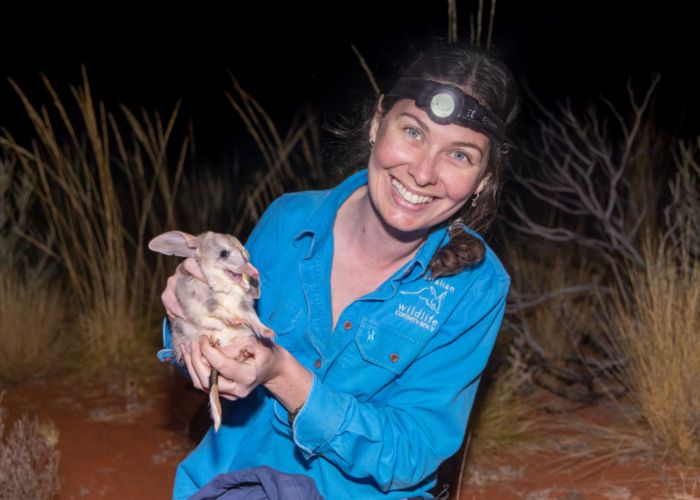 Brad Leue/AWC
Brad Leue/AWC
The increase in numbers can be attributed to several factors – a new population established at Newhaven Wildlife Sanctuary, the first estimate of a population established for several years at Mt Gibson Wildlife Sanctuary, and generous rainfall across most of Australia which replenished the landscape and provided good conditions for breeding.
Dr John Kanowski, AWC Chief Science Officer welcomed the increase in the overall Bilby population, saying it reiterates AWC’s position as a global leader in successful threatened species reintroductions.
“The Greater Bilby once occurred across 70% of mainland Australia, and sadly, is now only found within some 20% of its former range,” said Dr Kanowski. “This decline represents the loss of our natural heritage, the loss of cultural heritage for Indigenous people, and the disruption of important ecological processes – for example, as ‘ecosystem engineers’, Bilbies turn over several tonnes of soil per annum to create fertile pockets and perfect germination conditions for plants.”
“Through fenced refuges, such as those established by AWC, we have been able to return the Bilby to six ecosystems from which they’ve become extinct and provide them with safe environments in which they can safely breed and fertilise their numbers.
“Re-establishing the species across its former range is also important for maintaining long-term adaptive potential.”
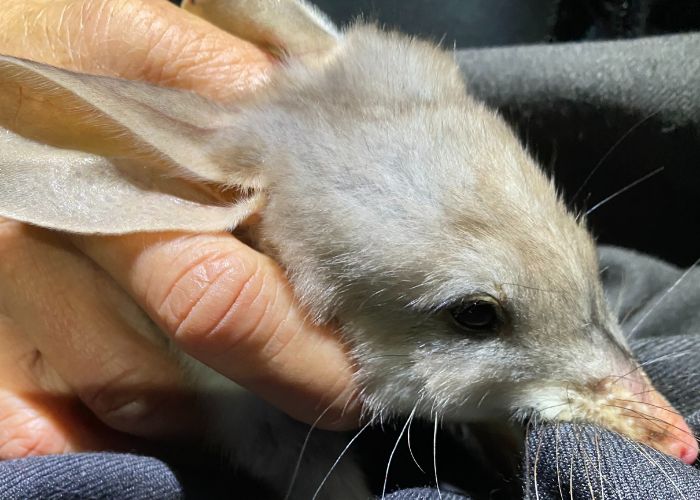 Dr Vicki Stokes/AWC
Dr Vicki Stokes/AWC
During surveys over the last year, ecologists were thrilled to encounter several juveniles and pouch young – 17 of 25 females captured during Pilliga’s December survey were carrying pouch young, while Newhaven Wildlife Sanctuary recorded its first photo evidence of a juvenile in November and observed juvenile tracks during a tracking survey.
Detections of young animals are a significant measure of the Bilby’s ability to survive into adulthood within the safe havens. The process of breeding also means new recruitment of individuals for the protected populations which will contribute to larger population estimates in the near future.
Sanctuaries with notable changes to their Bilby populations between May 2022 – March 2023:
“The population started with 56 individuals in 2016 and is now estimated to be about 1,770! We find Bilby diggings across the entire safe haven and regularly get Bilbies on remote cameras or see them when we are doing field work at night, so it was great to have our suspicions confirmed by the survey that we have a healthy-sized population.”
– Georgina Anderson, AWC Senior Field Ecologist
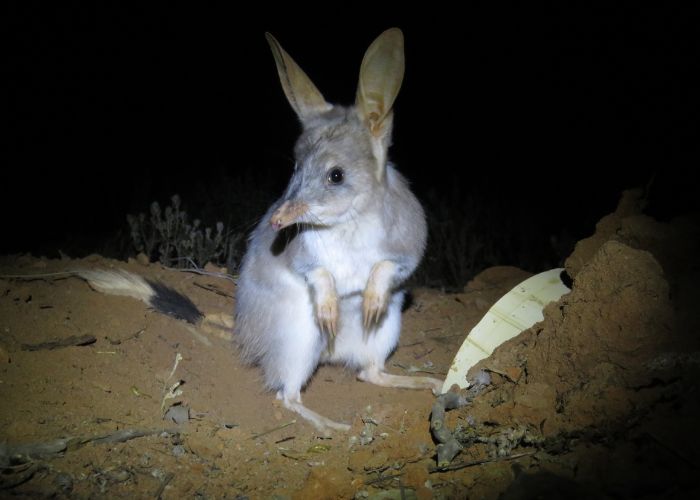 Dean Portelli/AWC
Dean Portelli/AWC
AWC has produced its first population estimate for Bilbies at Mt Gibson Wildlife Sanctuary – and according to the survey, the species is thriving!
Bilbies were reintroduced to Mt Gibson Wildlife Sanctuary between 2016 and 2018, with 56 individuals released into a 7,800-hectare feral predator-free area. Since then, AWC has closely monitored the population through camera detections as well as opportunistic trappings and sightings – all of which indicated that the species was doing well but didn’t provide ecologists with an overall population estimate.
In 2022, Mt Gibson Wildlife Sanctuary’s ecologists decided to trial a spotlighting survey to obtain the safe haven’s first Bilby population estimate. However, due to poor weather, the survey was cut short and the team was left with insufficient data to run the analysis. In February 2023, they decided to try again and to much success.
Mt Gibson Wildlife Sanctuary is estimated to have a population of around 1,770 Bilbies (give or take 400) – the largest Bilby population at an AWC sanctuary.
“From 56 to about 1,770! We are thrilled by this result,” said Georgina Anderson, AWC Senior Field Ecologist. “We were seeing more than 80 Bilbies every night during the spotlighting survey and came across quite a few subadults – this is evidence that the population is successfully breeding.”
Mt Gibson Wildlife Sanctuary population estimates:
2016-2018 – 56 founders
February 2023 – estimated 1,770 individuals
“We’ve had our first photo evidence of juveniles at Newhaven Wildlife Sanctuary. It’s a low-quality image but it’s another sign that the population has adapted to their new environment.”
– Samantha Mulvena, Australian Wildlife Conservancy Field Ecologist
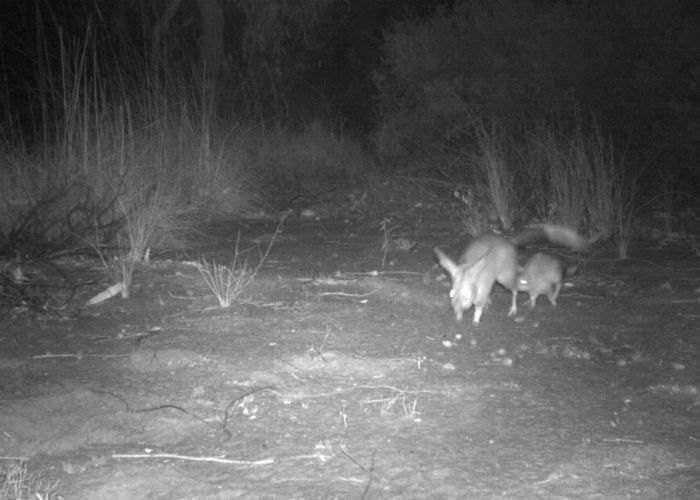 AWC
AWC
In 2022, AWC established a sixth population of the threatened Greater Bilby with a reintroduction to Newhaven Wildlife Sanctuary located on the traditional lands of the Ngalia-Warlpiri/Luritja people in Central Australia. It’s the first population under AWC’s protection in the region.
Sixty-six Bilbies were specially selected from Taronga Western Plains Zoo and Currawinya National Park in Queensland for the reintroduction into Newhaven’s 9,450-hectare feral predator-free area – one of Australia’s largest fenced safe havens.
AWC ecologists who have closely monitored the small mammals, say the founders were quick to start putting down roots or in their case, digging burrows.
“A few Bilbies were released with transmitters, allowing us to closely monitor how they moved and survived for the first two weeks,” said Samantha Mulvena, AWC Field Ecologist. “During this time, we had a 100% survival rate and we found individuals taking up shelter in spinifex dune fields, mulga woodland and spinifex sandplains. We also tracked one individual for 4 km from the release site to a new burrow – this was the furthest distance travelled and a good indication that the individuals had quickly acclimatised and are confidently moving around the new environment.”
“We continue to see positive signs of the Bilbies whenever we’re out in the field and this can be in the form of tracks, burrows and sightings on camera traps.”
In November-December 2022, Samantha and the team carried out a trackplot survey of 30x two-hectare plots and found Bilbies occupying almost half (47%) of sites and juveniles were detected at 10% of surveyed trackplot sites. In December 2022-January 2023, Bilbies appeared on 31 of 101 (31%) cameras used as part of a camera trap survey – an increase from 28 in September 2022. Excitingly, this survey delivered the first photo evidence of a young Bilby following its mum.
Newhaven Wildlife Sanctuary population estimates:
May 2022 – 66 founders
“Greater Bilbies in the Pilliga are doing very well – there are lots of healthy juveniles running around and Bilbies have already started to populate the wider fenced area, now that the last fox is gone.”
– Dr Vicki Stokes, Australian Wildlife Conservancy Senior Wildlife Ecologist
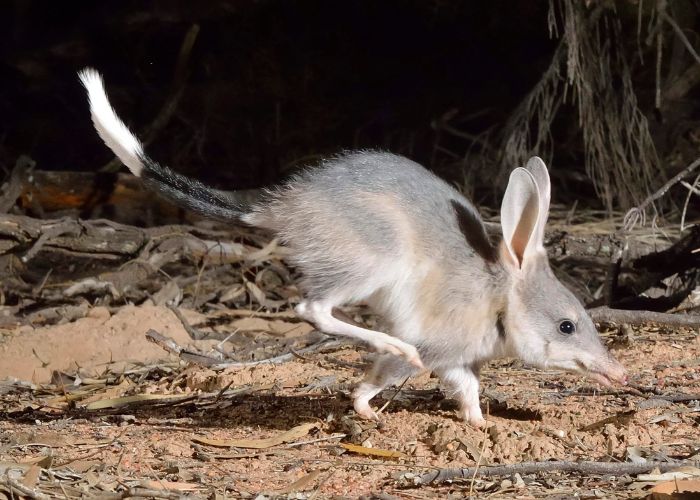 AWC
AWC
Since the Greater Bilby was reintroduced to the Pilliga State Conservation Area in 2018, the population has undergone boom and bust in line with weather conditions. Last year, despite the turmoil of two flood events, Bilbies maintained good numbers with a population estimate of 175 individuals and signs of successful reproductive recruitment.
Bilbies were reintroduced to the Pilliga almost a century after disappearing from the north-west NSW landscape. AWC with NSW National Parks and Wildlife Service (NPWS) released 60 individuals into a 680ha feral predator-free breeding area, where they have stayed until the final predator, a red fox, could be removed from the wider 5,800 ha fenced area.
Fortunately, the predator was ‘outfoxed’ by a couple of floods in October/November 2022 – just as the Bilby population neared maximum capacity in the breeding area.
During a trapping survey in December 2022 (the eighth survey on the population), ecologists captured 110 individuals. Of these, 48 bilbies were captured for the first time and 17 of the 25 females caught were carrying pouch young. This led to a population estimate of 175.
Although the December 2022 population estimate is lower than that obtained from the July 2022 survey (335), it is almost three times the founding population.
Dr Vicki Stokes, AWC Senior Wildlife Ecologist, said survey results indicate that the population is doing well and they are likely to thrive in the wider fenced area.
“The Pilliga experienced two extreme weather events in October and November last year which we believe contributed to the discrepancy between survey results and population estimates in July and December 2022,” explained Dr Vicki Stokes. “High rainfall and flash flooding of creeks and forest areas may have resulted in mortality of some Bilbies, particularly if burrows were impacted by the floods.”
“However, the high proportion of females with pouch young encountered during the December 2022 survey coupled with the healthy body weights and body condition of captured animals and sightings of numerous juveniles in February, suggest that the species continues to do well.”.”
Pilliga State Conservation Area population estimates:
November 2018 – 60 founders
October 2019 – 30 individuals
May 2020 – 55 individuals
December 2020 – 60 individuals
May 2021 – 50 individuals
December 2021 – 155 individuals
July 2022 – 335 individuals
December 2022 – 175 individuals
“We just finished our possum surveys and saw lots of tiny Bilbies out and about.”
– Dr Alexandra Ross, Australian Wildlife Conservancy Wildlife Ecologist
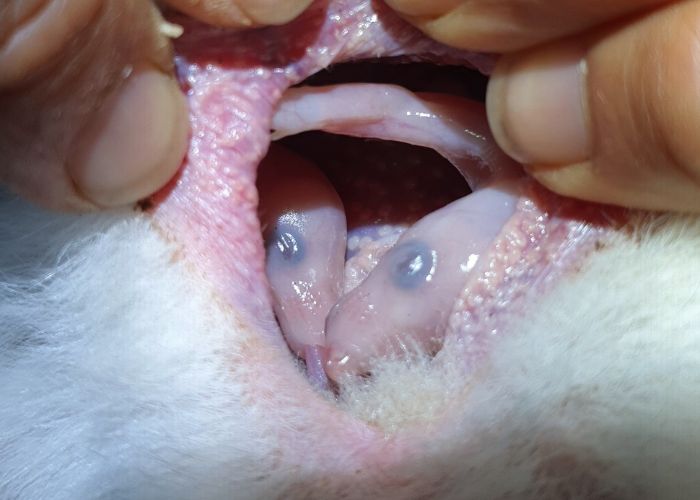 Dr Alexandra Ross/AWC
Dr Alexandra Ross/AWC
Yookamurra Wildlife Sanctuary’s estimated Bilby population remains unchanged from 2022, at 80 individuals. Despite this stability in numbers, ecologists have had several opportunistic baby Bilby encounters, indicating a successful breeding season.
Bilbies were reintroduced to Yookamurra in 1996 by Earth Sanctuary Ltd. as part of a breeding program. AWC acquired the property in 2002 and upgraded the predator-proof fence to establish a 1,100 hectares feral predator-free area. Bilbies were released into this wider area in 2007 and again in 2011 when the captive breeding program was discontinued.
Spotlight surveys were introduced at Yookamurra in 2015 to monitor the population which can fluctuate greatly between seasons.
Over the last few years, Yookamurra’s Bilby population has remained steady, averaging 80 individuals, which ecologists attribute to healthy rainfall and increased food conditions.
During a Common Brushtail Possum survey in February 2023, Dr Alexandra Ross and her team were fortunate enough to encounter up to six baby Bilbies over four nights. This coupled with a chance encounter with twin pouch young Bilbies during a
Burrowing Bettong survey in October last year, indicates that the population could be on the rise.
“We have seen lots of tiny Bilbies out and about, so we’ve definitely had a good Bilby season too,” Dr Alexandra Ross explained.
“We look forward to seeing how those young individuals contribute to the population estimate during a health survey in May this year.”
Yookamurra Wildlife Sanctuary population estimates:
2002 – AWC acquired Yookamurra where Bilbies were part of a breeding program
2007 – Bilbies released from breeding program into a 1,100 hectares feral free area
2015 – Spotlight surveys introduced to the sanctuary detecting an estimated 80 Bilbies
2017 – 130 individuals
2018 – 90 individuals
2019 – 125 individuals
2020 – 50 individuals
2021 – 80 individuals
2022 – 80 individuals
Support Australian Wildlife Conservancy's science-led conservation work and safeguard the future of Australia's native species
Donate Now